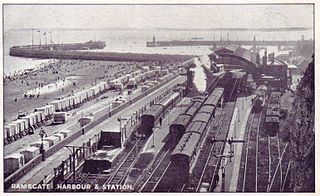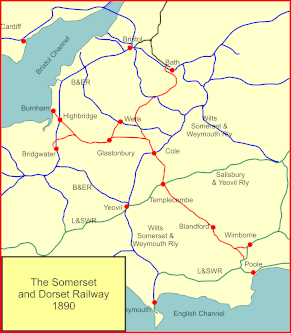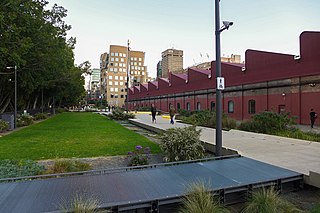
The Northern line is a London Underground line that runs from north to south London. It is printed in black on the Tube map. The Northern line is unique on the Underground network in having two different routes through central London, two southern branches and two northern branches. Despite its name, it does not serve the northernmost stations on the Underground, though it does serve the southernmost station at Morden, the terminus of one of the two southern branches.

The Piccadilly line is a deep-level London Underground line running from the north to the west of London. It has two branches, which split at Acton Town, and serves 53 stations. The line serves Heathrow Airport, and some of its stations are near tourist attractions such as Piccadilly Circus and Buckingham Palace. The District and Metropolitan lines share some sections of track with the Piccadilly line. Printed in dark blue on the Tube map, it is the fourth busiest line on the Underground network, with over 210 million passenger journeys in 2011/12.

Box Tunnel passes through Box Hill on the Great Western Main Line (GWML) between Bath and Chippenham. The 1.83-mile tunnel was the world's longest railway tunnel when it was completed in 1841.

The Rhaetian Railway, abbreviated RhB, is a Swiss transport company that owns the largest network of all private railway operators in Switzerland. Headquartered in Chur, the RhB operates all the railway lines of the Swiss canton of Grisons, except for the line from Sargans to the cantonal capital, Chur, which are operated by Swiss Federal Railways (SBB CFF FFS), as well as the line from Disentis/Mustér to the Oberalp Pass and further on to Andermatt, Uri, which is operated by Matterhorn Gotthard Bahn (MGB). Inaugurated in 1888 and expanded from 1896 onwards in various sections, the RhB network is located almost entirely within Grisons, with one station across the Italian border at Tirano.

The Avon Valley Railway (AVR) is a three-mile-long heritage railway based at Bitton station in South Gloucestershire, England, not far from Bristol and is run by a local group: The Avon Valley Railway Company Ltd. The railway follows the Avon Valley south-east from Oldland Common, through Bitton and alongside the River Avon towards Kelston and Bath. The railway shares its route with the Sustrans cycleway and footpath, the Bristol and Bath Railway Path.

A spiral is a technique employed by railways to ascend steep hills.
The term ruling grade is usually used as a synonym for "steepest climb" between two points on a railroad. More simply, the steepest grade to be climbed dictates how powerful the motive power must be in order for the run to be made without assistance. Even if 99% of the line could be run with a low-powered locomotive, if at some point on the line there is a steeper gradient than such train would be able to climb, this gradient "rules" that a more powerful locomotive must be used, in spite of it being far too powerful for the rest of the line. This is why special "helper engines" are often stationed near steep grades on otherwise mild tracks. It is cheaper than running a too-powerful locomotive over the entire track mileage just in order to make the grade, especially when multiple trains run over the line each day.

The Sapperton Railway Tunnel is a railway tunnel near Sapperton, Gloucestershire in the United Kingdom. It carries the Golden Valley Line from Stroud to Swindon through the Cotswold escarpment. It was begun by the Cheltenham and Great Western Union railway in 1839 and taken over by the Great Western Railway in 1843, being completed in 1845. There are actually two tunnels, the main one at 1 mi 104 yd (1.704 km) in length, and separated by a short gap, a second at 353 yd (323 m).

Combe Down Tunnel is on the now-closed Somerset and Dorset Joint Railway main line, between Midford and Bath Green Park railway station, below high ground and the southern suburbs of Bath, England, emerging below the southern slopes of Combe Down village.

The Bristol and Bath Railway Path is a 15-mile (24 km) off-road cycleway, part of National Cycle Network National Cycle Route 4. It has a 3-metre (9.8 ft) wide tarmacked surface, and was used for 2.4 million trips in 2007, increasing by 10% per year.
There are 22 disused railway stations in the 75 miles (121 km) between Bristol Temple Meads and Exeter St Davids, 12 of which have structures that can still be seen from passing trains. Most were closed in the 1960s but four of them, especially around Weston-super-Mare, were replaced by stations on new sites. 13 stations remain open on the line today, but there have been proposals to reopen stations at Cullompton and Wellington.

Staple Hill railway station was on the Midland Railway line between Bristol and Gloucester on the outskirts of Bristol. The station was on the Bristol and Gloucester Railway line, but opened in 1888, 44 years after the line had been opened through the site. It served the Victorian suburban developments in the area to the south of Mangotsfield.

Ramsgate Harbour railway station was a railway station in Ramsgate, in the Thanet district of Kent, England. Opened in 1863 as part of the Kent Coast Railway company's extension of its line from Herne Bay, it was conveniently situated for the seaside resort's beach, but it closed in 1926 after a reorganisation of railway lines in the Thanet area.

The Lötschberg line is a railway in Switzerland, connecting Spiez in the canton of Bern with Brig in the canton of Valais. It crosses the Bernese Alps, from the Bernese Oberland to Upper Valais, through the Lötschberg Tunnel in the middle of the line. Together with the Simplon Tunnel south of Brig, it constitutes one of the major railways through the Alps and an important north-south axis in Europe. The Lötschberg axis is backed by the lower and longer Lötschberg Base Tunnel, part of the New Railway Links through the Alps project.

Barry Pier railway station was a railway station in Barry Island, in Wales. It was the terminus of the Barry Island branch line, was authorised in 1896 and opened on 27 June 1899 when the line was extended from Barry Island railway station. There was a 280-yard (260 m) tunnel connecting the two railway stations which descended at a gradient of 1 in 80 (1.25%). The last steamer Balmoral called at the floating pontoon located beside the station in October 1971 and the last train in April 1973, but Barry Pier station was not officially closed until 5 July 1976.

Bramhope Tunnel is on the Harrogate Line between Horsforth station and the Arthington Viaduct in West Yorkshire, England. Services through the railway tunnel are operated mainly by Northern. The tunnel was constructed during 1845–1849 by the Leeds and Thirsk Railway. It is notable for its 2.138-mile (3.441 km) length and its Grade II listed, crenellated north portal. The deaths of 24 men who were killed during its construction are commemorated in Otley churchyard by a monument that is a replica of the tunnel's north portal.

Devizes railway station was the railway station serving Devizes in Wiltshire, England between 1857 and 1966. The station was on the Devizes branch line, between Pans Lane Halt and Bromham & Rowde.

Trelill is a hamlet in North Cornwall, United Kingdom. Trelill Tunnel carries the disused railway line to Wadebridge and Trelill Wood is in the valley of the River Allen.

The New Somerset and Dorset Railway, formed in early 2009, aims to restore the complete line of the Somerset and Dorset Joint Railway as a modern transport system for the 21st century. The group also has a heritage aspect, to encourage future use by steam specials, etc. Work is currently concentrated on five sites, Midford - Midsomer Norton - Gartell - Shillingstone - Spetisbury. Some of these are operated by independent groups.

The Goods Line is an 800 m-long (2,625 ft) linear park and shared pedestrian pathway and cycleway in the suburb of Ultimo, in the City of Sydney, New South Wales, Australia. The corridor connects Railway Square to Darling Harbour in the south and passes both the University of Technology Sydney Broadway campus and the Australian Broadcasting Corporation Sydney head office. The Goods Line terminates in the north at the corner of Sussex and Hay Streets, in the Sydney central business district.


















